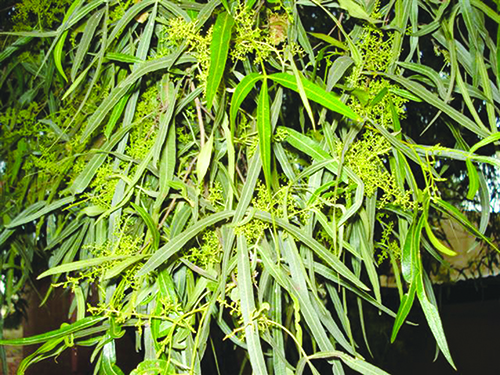THE Karee/ Willow Rhus (Searsia = Rhus lancea) is a tree or shrub, which usually grows along dry river beds. It is quite obvious when in full leaf and flowering during June to October, while the rest of the vegetation is quite drab and dry.
The drooping, yellowish green, three-fingered leaves and the dark, very rough trunk are very distinctive features. The leaflets are narrow and can be up to 12 cm long.
Names: German: Rivierweide, Afrikaans. Karee; Otjiherero: Oruzo; Damara/Nama: !Areb. The genus Rhus was recently renamed and is now known as Searsia, named after Paul B. Sears (1891-1990), former head of the Yale School of Botany. The specific name lancea refers to the long narrow leaflets. The karee tree occurs from the mountainous area around Otavi, Tsumeb and Grootfontein, where it is often found among the dolomite rocks, along the south-eastern escarpment to the Orange River, mostly along the dry river beds.
The Afrikaans common name “Karee” has the same origin as ‘Karoo’, the South African region in which this tree is also found in large numbers.
The karee is a small to medium-sized tree, up to eight metres high but may also form shrubs. The drooping habit of the branches is somewhat similar to that of a willow tree; however, the species are not related.
The trunk is covered by dark grey to brown to almost black and very rough bark while the twigs are smooth and reddish brown.
The karee tee flowers from June to October and looks at its best during these winter months. Old leaves drop in spring at the same time as the new leaves emerge. For this reason the tree appears to be evergreen. Trifoliate leaves, i.e. compound leaves made up of three leaflets, is the most obvious characteristic of the 15 Searsia-species occurring in Namibia.
The tiny yellowish-green flowers are very numerous. Male and female flowers grow on different trees, giving rise to small, yellowish-grey, somewhat flattened spherical fruits, about 5 mm in diameter.
The leaves are browsed by game and livestock, while birds love the fruits, which are also said to be an excellent chicken fodder. They may also be used to make beer. The flowers attract many bees. The karee tree is easily grown from seed or cuttings and is drought-, frost- and termite-resistant. It makes an attractive ornamental plant and can also be pruned to form a hedge. However, under cultivation it is often attacked by aphids, causing the leaves at the growing tips to curl up. A remedy is to cut off the affected tips and spray the tree with effective micro organisms. The karee tree is protected by forestry legislation.
A close relative, the ‘white karee’ (Searsia pendulina) is better suited to cultivation. It occurs naturally along the banks of the Orange River, where it frequently forms shrubby thickets, which at first glance look like a small type of bamboo. Searsia pendulina makes a graceful decorative tree, is fast-growing, but not very long-lived.
Stay informed with The Namibian – your source for credible journalism. Get in-depth reporting and opinions for
only N$85 a month. Invest in journalism, invest in democracy –
Subscribe Now!








